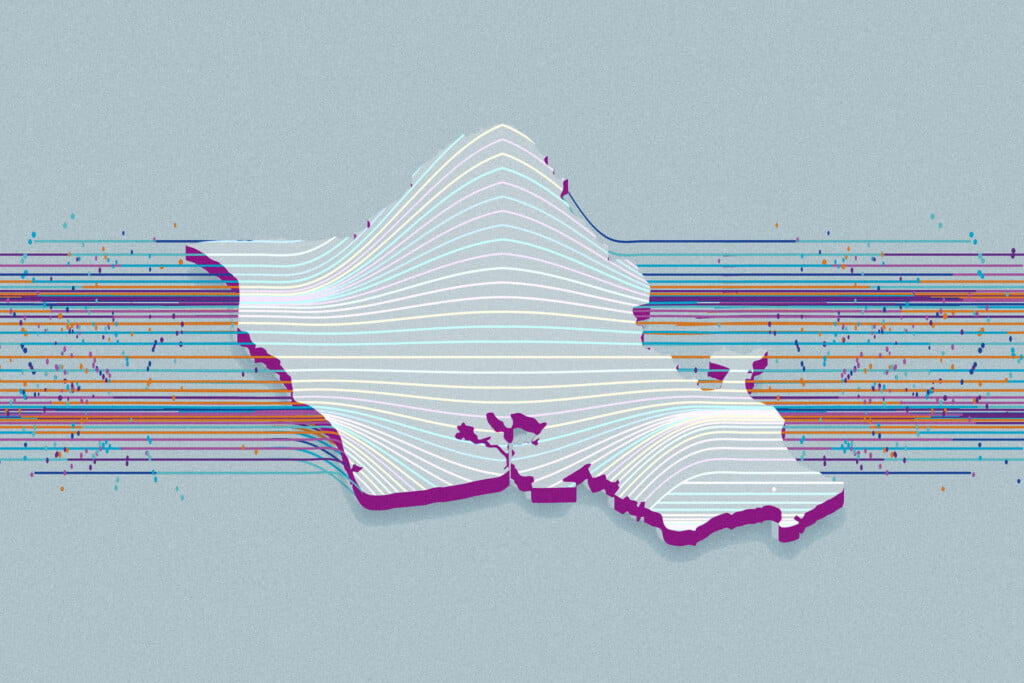At LAVA, There’s No Such Thing as Too Much Data
The lab at UH Mānoa visualizes complex information to help solve problems linked to tourism, climate change, the brain and more.

UH Mānoa is becoming a leader in data visualization, virtual reality, and artificial intelligence thanks to Jason Leigh and LAVA, the Laboratory for Advanced Visualization & Applications.
Leigh was formerly a professor and director of the Electronic Visualization Laboratory at the University of Illinois Chicago. In 2012, UH asked him to start a laboratory specializing in data analytics – that is interpreting, analyzing and communicating data – and computer graphics.
“Hawai‘i didn’t really have any kind of presence on the world stage for data visualization, virtual reality, game design, things like that. And so that was really the genesis of it, just unpacking a need for such a capability,” Leigh says.
LAVA’s goal is to help solve problems by providing scientists, policymakers and the public with data in visual and graphic ways that make the information easier to understand. A better understanding of the data, Leigh says, might help everyone make better decisions.
Work On Climate Science
LAVA’s projects vary: In May, the National Science Foundation awarded a five-year $20 million grant to Change HI, a collaboration between LAVA and other research teams on eight data and climate science-focused projects
“We work a lot with research scientists who are trying to, for example, solve climate change, or trying to figure out how we can help Hawai‘i reach 100% renewable (energy) by 2045,” Leigh says. “They usually come to us with data and hey say, ‘What’s a way to convey this data in a way that scientists can understand the data but also the general public can understand?’ … What are the trade-offs that you have to make? So it’s always a mixture of that pure science and the need for a problem to be solved.”
He says that when the team at LAVA analyzes a problem, they consider all its facets to determine the best possible solution. Team members may look at tourism and ask what tourists in Hawai‘i like most, so they can help businesses serve customers better. They may also consider tourism’s impact on the Islands to understand how to reduce any damage.
National Awards
Several LAVA projects have won awards. Graduate students Alberto González Martínez, Troy Wooton, Nurit Kirshenbaum and Dylan Kobayashi – and Leigh, their mentor – won Best Paper in Trending Now–Machine Learning and Artificial Intelligence for their work on Zexplorer, a human-moderated AI that analyzes research publications. Their award was received at the 2020 Practice & Experience in Advanced Research Computing conference.
At a 2022 national competition, three LAVA graduate students – Michael Rogers, Roderick Tabalba and Yoshiki Takagi – won with their submission of CyberCOP (Common Operating Picture), an application that uses virtual reality to help operators visualize satellite orbits and ward off cyberattacks.
One of LAVA’s biggest assets is the Destiny CyberCANOE at UH Mānoa, an extremely high-resolution hybrid reality visualization system. This research tool, funded by the National Science Foundation and the UH Academy for Creative Media, allows users to visualize big data in an immersive, 3D environment.
The Destiny CyberCANOE, Leigh explains, consists of a space the size of a large school classroom equipped with touch-enabled display walls that allow you to see “really exquisite three-dimensional images that are created by the computer,” simply by putting on lightweight 3D glasses like those handed out at movie theaters.
The high resolution comes from 256 million pixels on the screen, far more than anything previously developed. The OLED display technology – organic light-emitting diodes – was exclusive to Destiny CyberCANOE when it was created in 2016.
“So it was pretty much the best ver-sion of surround screen virtual reality that anyone had ever produced at the time,” says Leigh.
Seeing In An Immersive Way
A video from LAVA’s website demonstrates how this technology has proven helpful to professionals in a variety of fields. A psychiatrist, for example, can use it to better understand brain scans by seeing the structure of the brain in an immersive, up-close way. Environmental scientists may use it to better visualize the data they’ve collected on remote problems like ice melt in the Arctic.
A few of LAVA’s projects have a connection to Polynesian culture, such as its free, online Sāmoan/English Dictionary, which makes translating easier and more accessible. They also created Kilo Hoku VR, a virtual reality simulation of sailing on the Hōkūle‘a that helps users understand the application of astronomy in Hawaiian wayfinding.
The LAVA logo draws inspiration from data visualization iconography and Polynesian tattoo art and includes a wave design. In both data visualization and Polynesian tattoos, the goal is storytelling.
Leigh says the laboratory has hired about 50 students who have been awarded grants from the National Science Foundation and other sponsors such as the U.S. Department of Energy, the military, NSA, Oceanit, Hawaiian Electric and the Hawai‘i State Energy Office.
Learn more at lavaflow.info.
Related: A look inside UH West O‘ahu’s Digital Emerging Media Lab






